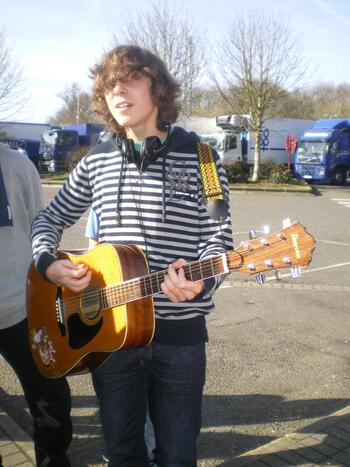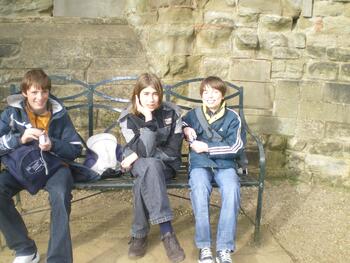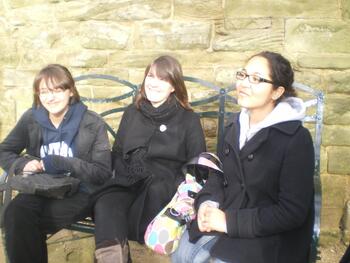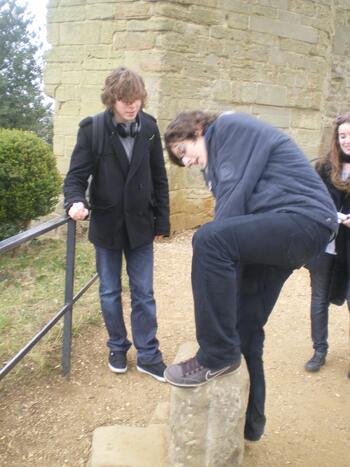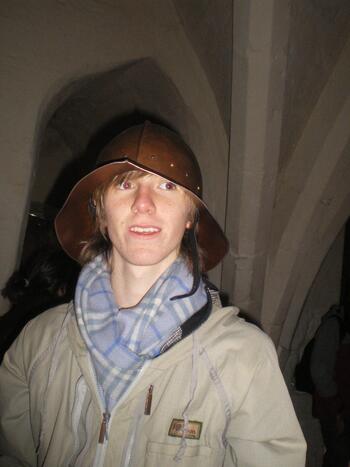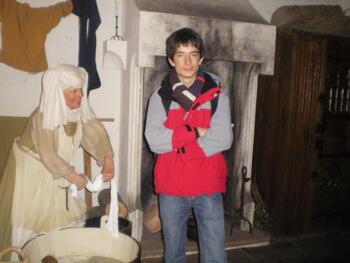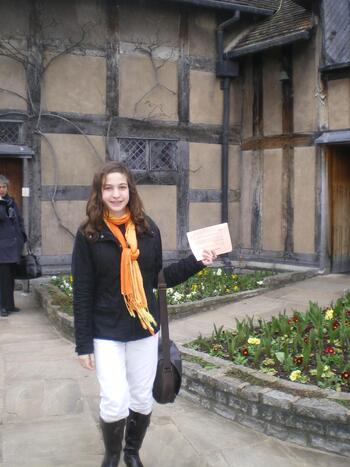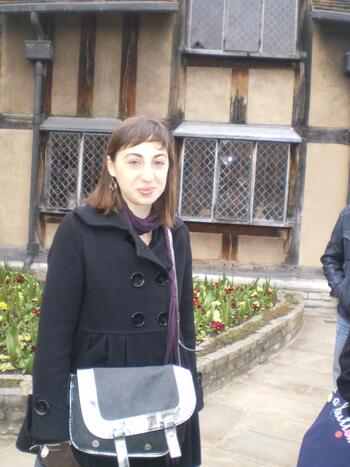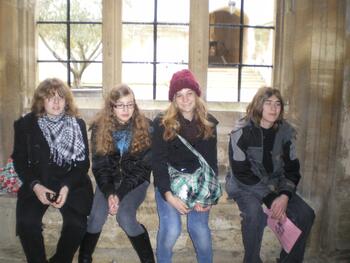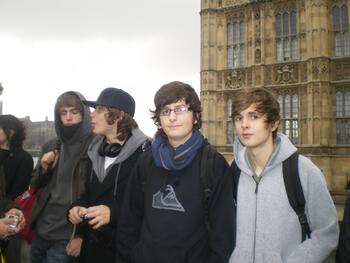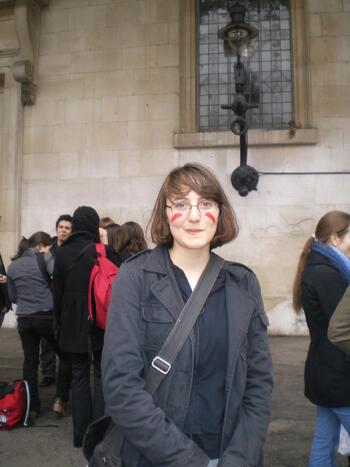-
Par zeuros le 3 Octobre 2009 à 21:10
After the Second World War, disabled, tryed to revive, and in spite of the idea of an international solidarity which would go on the remains of tensions, advocated by several governments and institutions ( don't forget that UNO was created in 1945), some political divergences and conflicts grew worse, and progressively split the Old Continent...Fortunately, many texts, speeches, maps...illustrate these Cold War"s beginnings...
For example, the document one, an extract from the speech pronounced by the British politician , Winston Churchill, on March the 5th in 1946, during a meeting with United States of America's president, Harry Truman, in Fulton, in Missouri, is very famous and emblematical, since it evokes tensions between Western and Eastern Europe, which were abstractedly separated by the " Iron Curtain ", expression that was invented, globalized and became a keyword during the Cold War, thanks to the former British Prime Minister, that day...
The document two, a map extracted from the school book, European Sections, published by Magnard in 2004, also refers to this period, showing us Europe's configuration during the Cold War - which roughly began after the war until the early nineties, it depens on the historians's opinion -. In fact, on the one hand, there is the Western Block, union of NATO members, and on the other hand, we find the Eastern block, composed of the members of the Warsaw pact, separated by an Iron Curton, became a concrete symbol of a deep political and ideological division, which spread out from Berlin to Greece...So, in view of this proof of the deterioration of relationship between European countries soon after the war, we could wonder :
how did the Cold War dvide Europe ?
At first, we're going to focus on this part of Churchill's speech. Indeed, it evokes the " Iron Curtain ", very important notion symbolizing the break between "Stettin" and "Trieste", the first city representing Poland, so the Eastern block, and the second, in Italy, the Western one. He insists - what explains the importance of this speech -, on Soviet Russia, one of the sources of this rupture, since in a desire of expansion's name, Moscow controled cities like "Warsaw", "Vienna"...and isolated them from the rest of Europe, and even, of the world ( we think about USA ). So, all an European portion withdrew into itself, because of ideological reasons, advocated by Moscow, proud of its country's victory. These reasons were, for example, the USSR's desire of propagating its doctrines, its longings for a political pre-eminence proudly assumed by Staline, who led a policy for this. Very quickly, national, patriotic interests of some areas, crackes international harmony and provoked the Cold War...
Lastly, and concretely, if we study the map, we realize that it makes clear Churchill's speech. Indeed, we can see on the one hand, the Western Block, and on the other hand, the Eastern one. This one is composed of countries joined by the Warsaw pact. What is the Warsaw pact ? It is a military alliance concluded the 14th of May in 1955 between communist block members ( Hungary, Czechoslovakia...), to make official their friendship and their mutual aid, under the aegis of Khrouchtchev. It was conceived like a counterbalance to NATO, born in 1949, and which is also a politico-military organization of which signatories are, for example, France, Belgium, Deutschland, Canada, anyway, Occidental countries. It ensures Europe's defence and security ; its main rival was the Warsaw pact...
So, to conclude, we can say that the two powers, these two organizations confronted each other, as these documents indicate us, from 1945, the tensions after war continuing to persist and leding to the Cold War, which, unlike the both world wars, was only an ideological war, without gigantic shellings or deaths, between two blocks well separated which didn't understand each other, and didn't manage to win their friendship, blinded by their own patriotic interests...
 votre commentaire
votre commentaire
-
Par zeuros le 3 Octobre 2009 à 21:10
After the Second World War, disabled, tryed to revive, and in spite of the idea of an international solidarity which would go on the remains of tensions, advocated by several governments and institutions ( don't forget that UNO was created in 1945), some political divergences and conflicts grew worse, and progressively split the Old Continent...Fortunately, many texts, speeches, maps...illustrate these Cold War"s beginnings...
For example, the document one, an extract from the speech pronounced by the British politician , Winston Churchill, on March the 5th in 1946, during a meeting with United States of America's president, Harry Truman, in Fulton, in Missouri, is very famous and emblematical, since it evokes tensions between Western and Eastern Europe, which were abstractedly separated by the " Iron Curtain ", expression that was invented, globalized and became a keyword during the Cold War, thanks to the former British Prime Minister, that day...
The document two, a map extracted from the school book, European Sections, published by Magnard in 2004, also refers to this period, showing us Europe's configuration during the Cold War - which roughly began after the war until the early nineties, it depens on the historians's opinion -. In fact, on the one hand, there is the Western Block, union of NATO members, and on the other hand, we find the Eastern block, composed of the members of the Warsaw pact, separated by an Iron Curton, became a concrete symbol of a deep political and ideological division, which spread out from Berlin to Greece...So, in view of this proof of the deterioration of relationship between European countries soon after the war, we could wonder :
how did the Cold War dvide Europe ?
At first, we're going to focus on this part of Churchill's speech. Indeed, it evokes the " Iron Curtain ", very important notion symbolizing the break between "Stettin" and "Trieste", the first city representing Poland, so the Eastern block, and the second, in Italy, the Western one. He insists - what explains the importance of this speech -, on Soviet Russia, one of the sources of this rupture, since in a desire of expansion's name, Moscow controled cities like "Warsaw", "Vienna"...and isolated them from the rest of Europe, and even, of the world ( we think about USA ). So, all an European portion withdrew into itself, because of ideological reasons, advocated by Moscow, proud of its country's victory. These reasons were, for example, the USSR's desire of propagating its doctrines, its longings for a political pre-eminence proudly assumed by Staline, who led a policy for this. Very quickly, national, patriotic interests of some areas, crackes international harmony and provoked the Cold War...
Lastly, and concretely, if we study the map, we realize that it makes clear Churchill's speech. Indeed, we can see on the one hand, the Western Block, and on the other hand, the Eastern one. This one is composed of countries joined by the Warsaw pact. What is the Warsaw pact ? It is a military alliance concluded the 14th of May in 1955 between communist block members ( Hungary, Czechoslovakia...), to make official their friendship and their mutual aid, under the aegis of Khrouchtchev. It was conceived like a counterbalance to NATO, born in 1949, and which is also a politico-military organization of which signatories are, for example, France, Belgium, Deutschland, Canada, anyway, Occidental countries. It ensures Europe's defence and security ; its main rival was the Warsaw pact...
So, to conclude, we can say that the two powers, these two organizations confronted each other, as these documents indicate us, from 1945, the tensions after war continuing to persist and leding to the Cold War, which, unlike the both world wars, was only an ideological war, without gigantic shellings or deaths, between two blocks well separated which didn't understand each other, and didn't manage to win their friendship, blinded by their own patriotic interests...
 votre commentaire
votre commentaire
-
Par zeuros le 27 Septembre 2009 à 11:34
Barry Lyndon ( 1975)
by Stanley Kubrick (Lolita, A Clockwork Orange, Paths of Glory...)
adapted from a novel by William Makepeace Thackeray
This excellent movie relates the story of Barry Lyndon, a young modest man who climbs grades from the aristocratic life and becomes the biggest English crook in the 18th century.
To me, it's a very interesting and fascinating movie where all the actors are great. As for music, she was written by the highest composers like Mozart, Bach, Schubert, Haendel, Vivaldi... (of course, music was choose by Kubrick).
The film won 4 Oscars, a lot of wins and nominations.
So, I'll give you a piece of advice : Watch this movie, just watch and watch again !
L.P 2nde11
 votre commentaire
votre commentaire
-
-
Par zeuros le 11 Mars 2009 à 08:44AUCUN ELEVE N'EST AUTORISE A CHANGER L'APPARENCE DU BLOG. EN CAS DE RECIDIVE, JE FERME TOUT !
 votre commentaire
votre commentaire Suivre le flux RSS des articles de cette rubrique
Suivre le flux RSS des articles de cette rubrique Suivre le flux RSS des commentaires de cette rubrique
Suivre le flux RSS des commentaires de cette rubrique
